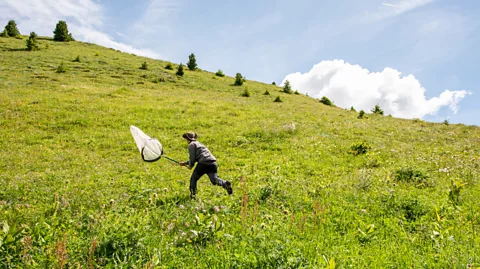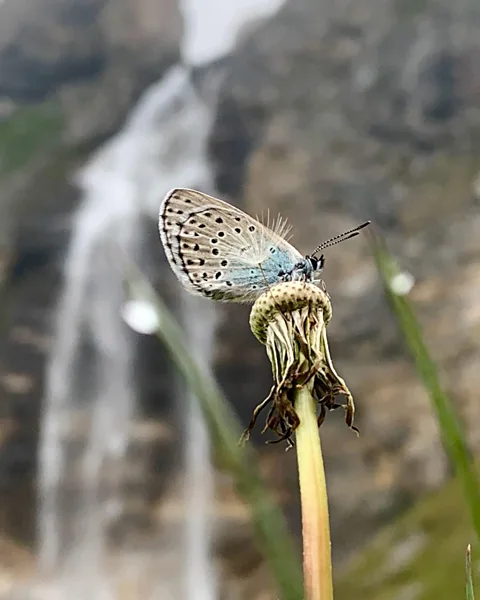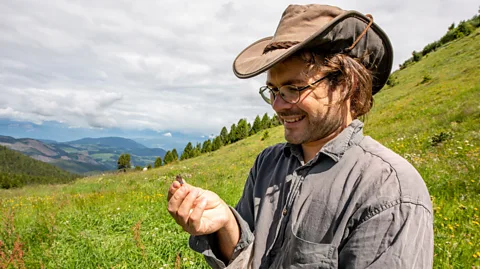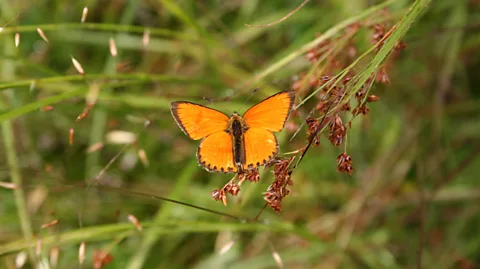Why the Alps are a haven for rare butterflies
 Eurac Research/Martina Jaider
Eurac Research/Martina JaiderHumans and butterflies have lived in harmony for centuries in the Alps. As climate change threatens their populations, people are working to ensure the mountains remain a haven for rare butterflies.
In summer 2021, Bernhard Auckenthaler was preparing an evening aperitif at his organic herb farm in the northern Italian Alps, when he spotted a mysterious woman with a net walking through a nearby meadow. She turned out to be a biologist monitoring butterflies in the area, and had just made an exciting discovery among the wildflowers next to his farm: a species called the 'large blue', an endangered butterfly.
The European Alps have been described as a "butterfly diversity hotspot", with more than 250 species including threatened ones such as the apollo (Parnassius apollo), the hermit (Chazara briseis) and the damon blue (Polyommatus damon). Some, such as the zephyr blue (Plebejus trappi), are endemic to the Alps.
This is partly thanks to the varied landscape of the Alps, where many different natural ecological niches sit closely together. But human influence has also played a part. For centuries, farmers have used the rocky, nutrient-poor grasslands high up in the mountains to graze their animals or mow hay for the winter. In the process, they created grasslands rich in plants and butterflies. Such traditional, unfertilised Alpine meadows host more than three times as many plant species than intensively managed, fertilised ones, according to one study.
"This ecological wealth is right on our doorstep," says Auckenthaler, as he gestures towards the fragrant beds of edelweiss, lemon savoury and wild oregano at his herb farm, with pollinators buzzing and fluttering through the air. "We have something unique here, in terms of the diversity of plants, insects, and butterflies."
But many of these Alpine sanctuaries are under threat. Even relatively small changes – such as the use of fertiliser to boost hay production – can tilt the ecological balance of a meadow. A closer look at the large blue, known as Phengaris arion (previously called Maculinea arion), illustrates why such changes can especially affect certain highly specialised butterflies.
 Elia Guariento
Elia GuarientoIn Europe's lowlands, the large blue is "as good as extinct", mainly due to the spread of intensive farming, according to Johanna Propstmeier, an independent biologist. She was the one who spotted it near Auckenthaler's farm in 2021, when she was collecting data for a butterfly monitoring project led by the University of Innsbruck and other institutions.
In places such as the Netherlands, Belgium and northern France, the large blue has been reduced to isolated, dwindling populations, she says. But "in the mountains, the situation is still a bit better than in the lowlands". That's because in the mountains, "intensive agriculture can't push into every area yet. Many Alpine grasslands are used as pastures."
These warm, nutrient-poor pastures offer the right conditions not only for the large blue, but also for the other species involved in its complex, colourful life cycle: thyme, and ants.
The large blue's larva starts its life in the flowers of wild thyme or oregano. After about three weeks, it drops to the ground and waits for Myrmica sabuleti ants to arrive. It has to be this specific ant; other species of Myrmica ant would treat the larva as prey, and eat it. When the right ants arrive, the butterfly larva imitates the sounds and smells of Myrmica sabuleti larvae, which fools the ants into carrying it back to their nest and raising it as one of their own. Still undetected, the larva feeds on the ants' own grubs. After about 10 months, it turns into a butterfly and quickly escapes the nest before the ants can realise the deception and attack it.
Other types of large blue have their own specific host plants, and each can only trick specific types of Myrmica ant.
"Their way of life is so complex because the habitat has to be appropriate not just for the large blue butterflies, but also, their host ants, the plants that feed that caterpillars, and the flowers that provide nectar for the butterflies," says Propstmeier.
Relatively small changes can break that complex web. When a meadow is heavily fertilised, for example, other plants take over and push out the thyme, which prefers nutrient-poor soil, she says. Grazing animals avoid thyme, but keep the pasture short – which is another crucial factor, since grass length really matters for the large blue and its supporting species.
In the UK, Phengaris arion became extinct after farmers stopped grazing their animals in its habitat, and the grass grew too long, which cooled the soil. The cooler soil did not suit the Myrmica sabuleti ants. Scientists recommended restoring the habitat by clearing shrub and letting animals graze there. The butterfly was then successfully reintroduced.
A recent study, based on a broader project that monitors butterfly diversity in South Tyrol in northern Italy, highlights the huge importance of such Alpine pastures and meadows not just for the large blue, but for butterfly diversity in general.
Comparing areas such as pastures, meadows, orchards and vineyards, the researchers found the highest butterfly diversity within traditional pastures and meadows, and the lowest in intensively farmed monocultures such as apple orchards. They recorded 100 butterfly species in total, ranging from 32 found in traditional pastures, to just one in apple orchards.
Semi-intensively managed meadows landed in-between in terms of their diversity, suggesting that the more traditional the management, with little or no fertiliser, the better for butterflies.
This varied landscape is also in itself beneficial for butterfly diversity, says Elia Guariento, an ecologist and entomologist at Eurac Research in Bolzano (Bozen) in South Tyrol, who co-authored the study.
"One aspect that's characteristic of a mountain environment is that different habitats are not just close to each other, but also, the management of the landscape is more fragmented," he says. "So we tend not to have bigger areas that are cultivated in the same way, but a mosaic combination of different land use types, and different habitats, which increases the diversity of butterflies."
 Eurac Research/Martina Jaider
Eurac Research/Martina JaiderAs a result of this varied land use, there can be subtle, diversity-boosting differences even between quite similar habitats, he says. For example, pastures, which are used for grazing, are typically quite patchy, as the animals trample across the surface, eat some plants and avoid others. Meadows tend to be more uniform, because they are mown: "The variability in the vegetation and structure of a pasture is way higher than in a meadow." This allows slightly different communities of butterflies to thrive there.
Perhaps surprisingly, while over-fertilising can harm diversity, so can letting nature take its course, at least in the short term.
Research shows that traditional meadows feature a greater plant diversity than abandoned land, where a few species tend to dominate, gradually turning the pasture or meadow into a forest. For butterflies adapted to blooming meadows, it can be difficult or even impossible to survive in the changed habitat. A study of changes in Alpine butterfly communities in north-west Italy over the course of 40 years observed a decline in specialised species, and rise in more tolerant, mobile species. One reason was thought to be the marked reduction of grasslands and expansion of forests, due to a decline in cattle grazing, as well as warming temperatures.
Saving ancient pastures
Unfortunately, the traditionally managed meadows and pastures where butterflies thrive "are a minority, a remnant of former land-use practices that is quite abandoned", says Guariento. "The really dominant land-use types are the ones where butterflies are not doing so well." This includes apple orchards and vineyards, which continue to expand, he says, also because climate change now allows for cultivation at higher altitudes.
Climate change is also forcing some butterflies to migrate to cooler areas at higher elevations. But as there is less land at the top, says Karel Cerny, an Innsbruck-based zoologist and entomologist, the reduced area may not provide sufficient space for certain species, or may be simply unsuitable for them.
The threat to Alpine butterflies follows similar developments in the rest Europe, where butterflies have been hit by the spread of intensive farming, habitat loss and chemical pollution. One review of butterfly populations in the UK, the Netherlands and Belgium found that in the UK, the abundance of butterflies has roughly halved since 1976. In the Netherlands, abundance has declined by almost 50% since 1990. In north Belgium, data revealed in the early 2000s that 19 of 64 indigenous species (30%) had become extinct and that 18 species (28%) were threatened with extinction.
One way to stem the decline in the Alps is to join forces with farmers, says Guariento, for example by paying them to maintain traditional meadows and pastures, as in the case of European Union farm subsidies.
"From a conservation perspective I see a lot of potential in this," he says, referring to the subsidies. "Farmers not only earn and produce for themselves, but are also keepers of the cultural landscape."
Cerny agrees that protecting traditional pastures and meadows would be ideal, but also sees challenges. "When it comes to conserving butterflies, continuing the traditional type of land use would be best," he says. "The plants and animals have adapted to this for millennia. But that vision isn't really feasible on a large scale anymore, because traditional agriculture isn't financially attractive. The quality of the products [such as cheese and dairy] would be good, but the quantity would be too small, and it would be too labour-intensive."
Managing the path of avalanches down mountain slopes could also aid butterfly numbers, as biodiversity has been found to be higher in the tracks of avalanches than surrounding land (read more about how avalanches boost biodiversity).
Cerny is chairman of of Jaro Austria, a non-profit organisation dedicated to conservation. Jaro's volunteers try to help butterflies by manually clearing abandoned grasslands of shrubs and bushes, reversing some of the encroachment. But Cerny also highlights more indirect threats to butterflies, such as the expansion of ski resorts, which can harm the local plant life. (Read more about how skiing is evolving with climate change.)
 Eurac Research/Andreas Hilpold
Eurac Research/Andreas HilpoldScientists at the University of Innsbruck have also taken steps to raise wider awareness of butterflies and their needs, by enlisting school children and other lay people as citizen scientists in a butterfly monitoring project in Austria that recorded more than 100 species. The project's findings chimed with the results of other studies, showing that the greatest diversity was found in mountain pastures and meadows, and the lowest, in the intensively farmed valleys.
Carbon count
The emissions from travel it took to report this story were 0kg CO2, given Sophie was already in South Tyrol for reasons other than this reporting assignment. The digital emissions from this story are an estimated 1.2g to 3.6g CO2 per page view. Find out more about how we calculated this figure here.
"Interestingly, it was the children who got their families interested in the subject," says Ulrike Tappeiner, a professor of ecosystem research and landscape ecology at the University of Innsbruck. She recounts how a group of school children who took part in the project ended up planting a local traffic island with plants for pollinators.
Auckenthaler, the herb farmer, believes that the key is to show locals the economic benefits of nature and diversity. His own parents were dairy farmers, but enthusiastically supported his idea of transforming the ancestral farm into a herb farm. Given the economic struggles of traditional dairy farming, he believes it's vital to think of other, sustainable ways to make a living in the Alps.
One could be to combine tourism, already a huge source of income in the region, with farming that makes the most of the area's diversity and traditions. His business partners, Gabi and Sepp Holzer, also transformed a traditional dairy farm into a herb farm. Now they jointly market their herb mixes and teas, as well as offering guided hikes and tasting events– and in future, perhaps, butterfly walks, to spot the large blue.
"It would be wrong to say that we want to live under a cheese cloche here," warding off any form of human activity or intrusion, he says. "That might work in a national park. Here, humans need to make a living, too."
--
